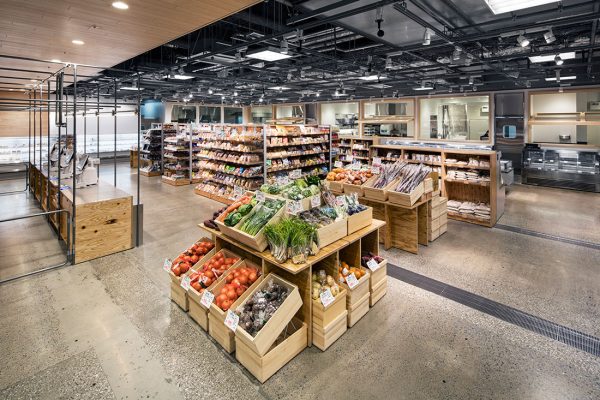A supermarket that makes you want to linger? Jo Nagasaka of Schemata Architects brought the unlikely notion to physical reality with a communicative interior for Fukushimaya Tasting Market in Tokyo.

Photography by Kenta Hasegawa
January 5th, 2018
Online shopping has brought about a number of shifts in retail design in recent years and that’s a good thing. Designers are now making interiors work harder than ever before just to stay in competition with agile digital environments where everything is about cost cutting and convenience. Good retail design adds value to physical businesses and through a revitalised focus on people, integrating a sense of storytelling and creating memorable in-store experiences, designers are implementing different strategies to achieve increased functionality.

Supermarkets are quite possibly the ultimate measure of retail design efficiency because they need to be constantly updated to meet customers’ fluctuating expectations. For Jo Nagasaka, acknowledgement of the fact that the supermarket and consumer of a decade ago aren’t the supermarket and consumer of today became the basis for designing the Fukushimaya Tasting Market in Akihabara, Tokyo.
His resulting scheme for the modestly sized supermarket takes its visual cue from a traditional open market concept, where everything is on show and within reach. There’s plenty of room to move around in the aisles, and the display systems themselves appeal for their relatively lo-fi, rustic aesthetic. Nagasaka had a tight budget to work with and this may have initially guided his economical material palette. But it certainly didn’t compromise the quality of the fit-out’s nature-inspired craftsmanship and detailing, or its innovation.

Galvanised steel pipes are used as a minimalist yet effective wayfinding device at the point of sale, while elsewhere, organically grown, pesticide-free vegetables are displayed in neatly arranged raw timber wine boxes. These boxes speak ‘fresh from the garden’ and also allow for flexibility in how the produce is displayed. So in accordance with the seasons or time of day, these boxes can be re-arranged to best showcase the current produce available.
It’s a simple design strategy that keeps customers engaged by offering them different narratives, depending on when they go shopping.
Read the full story in Cubes issue 89 – on sale now!
A searchable and comprehensive guide for specifying leading products and their suppliers
Keep up to date with the latest and greatest from our industry BFF's!

In the pursuit of an uplifting synergy between the inner world and the surrounding environment, internationally acclaimed Interior Architect and Designer Lorena Gaxiola transform the vibration of the auspicious number ‘8’ into mesmerising artistry alongside the Feltex design team, brought to you by GH Commercial.

Savage Design’s approach to understanding the relationship between design concepts and user experience, particularly with metalwork, transcends traditional boundaries, blending timeless craftsmanship with digital innovation to create enduring elegance in objects, furnishings, and door furniture.

Suitable for applications ranging from schools and retail outlets to computer rooms and X-ray suites, Palettone comes in two varieties and a choice of more than fifty colours.

An entry by MuseLAB, in The Retail Space in the 2024 INDE.Awards, takes shoppers to another planet where diamonds and great interior design make a lasting impression.

A hospitality venue in the heart of Osaka comprising four dining options – a place where nostalgic pastimes meet high-end dining.
The internet never sleeps! Here's the stuff you might have missed

Third in the series of boutique hotels under the Lloyd’s Inn brand, Lloyd’s Inn Kuala Lumpur bring the immediacy of nature to the new high-rise hospitality experience in the heart of a bustling city.

When iconic brands wield their influence, the ripples extend far beyond aesthetics. And so when the MillerKnoll collective formed, the very concept of design shifted, supercharging the industry’s aspiration to create a better world into an unwavering sense of responsibility to do so.